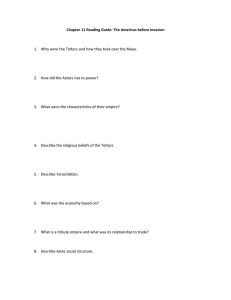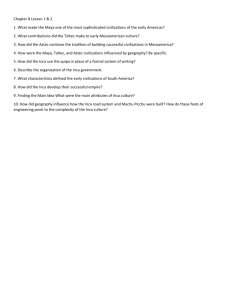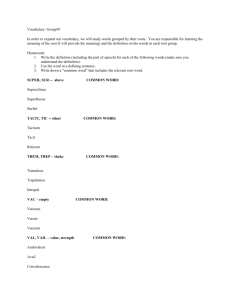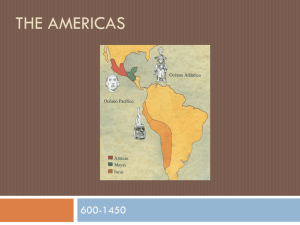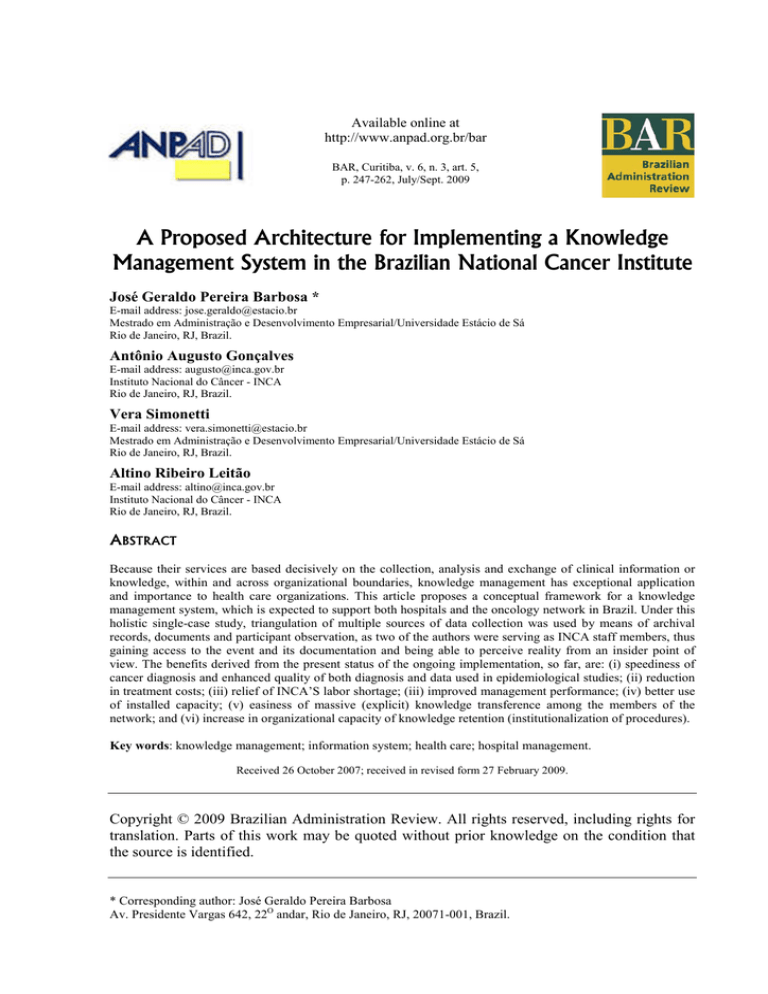
Available online at
http://www.anpad.org.br/bar
BAR, Curitiba, v. 6, n. 3, art. 5,
p. 247-262, July/Sept. 2009
A Proposed Architecture for Implementing a Knowledge
Management System in the Brazilian National Cancer Institute
José Geraldo Pereira Barbosa *
E-mail address: jose.geraldo@estacio.br
Mestrado em Administração e Desenvolvimento Empresarial/Universidade Estácio de Sá
Rio de Janeiro, RJ, Brazil.
Antônio Augusto Gonçalves
E-mail address: augusto@inca.gov.br
Instituto Nacional do Câncer - INCA
Rio de Janeiro, RJ, Brazil.
Vera Simonetti
E-mail address: vera.simonetti@estacio.br
Mestrado em Administração e Desenvolvimento Empresarial/Universidade Estácio de Sá
Rio de Janeiro, RJ, Brazil.
Altino Ribeiro Leitão
E-mail address: altino@inca.gov.br
Instituto Nacional do Câncer - INCA
Rio de Janeiro, RJ, Brazil.
ABSTRACT
Because their services are based decisively on the collection, analysis and exchange of clinical information or
knowledge, within and across organizational boundaries, knowledge management has exceptional application
and importance to health care organizations. This article proposes a conceptual framework for a knowledge
management system, which is expected to support both hospitals and the oncology network in Brazil. Under this
holistic single-case study, triangulation of multiple sources of data collection was used by means of archival
records, documents and participant observation, as two of the authors were serving as INCA staff members, thus
gaining access to the event and its documentation and being able to perceive reality from an insider point of
view. The benefits derived from the present status of the ongoing implementation, so far, are: (i) speediness of
cancer diagnosis and enhanced quality of both diagnosis and data used in epidemiological studies; (ii) reduction
in treatment costs; (iii) relief of INCA’S labor shortage; (iii) improved management performance; (iv) better use
of installed capacity; (v) easiness of massive (explicit) knowledge transference among the members of the
network; and (vi) increase in organizational capacity of knowledge retention (institutionalization of procedures).
Key words: knowledge management; information system; health care; hospital management.
Received 26 October 2007; received in revised form 27 February 2009.
Copyright © 2009 Brazilian Administration Review. All rights reserved, including rights for
translation. Parts of this work may be quoted without prior knowledge on the condition that
the source is identified.
* Corresponding author: José Geraldo Pereira Barbosa
Av. Presidente Vargas 642, 22O andar, Rio de Janeiro, RJ, 20071-001, Brazil.
José Geraldo Pereira Barbosa, Antônio Augusto Gonçalves, Vera Simonetti, Altino Ribeiro Leitão
248
INTRODUCTION
Brazil currently has a complex cancer scenario. General incidence and mortality rates are elevated,
with the particularly high incidence of prostate cancer in men and breast cancer in women. Theses
cases have been responsible for over one hundred thousand deaths per year. There are approximately
480,000 new diagnoses of cancer each year in Brazil, and the vast majority of these patients have had
some contact with hospital services. However, research also shows that in several regions of the
country long waiting lists for diagnostics and treatments have become commonplace, which leads to a
situation of people being diagnosed with cancer at a very advanced stage (National Cancer Institute
[INCA], 2008). These sad findings have moved the national health care ministry in recent years to
initiate a series of challenging reforms in order to implement early diagnosing clinical procedures. The
management of cancer treatment is a long and complex process and the reduction of the patient’s
waiting time to start cancer treatment plays an increasingly important role. Therefore, any environment
focusing on the accessibility to the treatment of a chronic illness like cancer should make every effort
to avoid medical errors and fragmentation of care delivery.
The huge number of cancer cases in Brazil means that information is highly sought after by patients
and the clinicians involved in their care and those responsible for cancer services, which opens an
opportunity window for implementing hospital information systems [HIS]. Hoping to bring together
people involved in care planning and delivering - clinicians, managers and patient representatives, the
Instituto Nacional de Cancer (National Cancer Institute [INCA]) has been implementing an oncology
care network. The network, as conceived by the INCA, is a partnership of both private and public
cancer care delivery organizations, whose success will depend heavily on the collection, analysis and
exchange of clinical and managerial information or knowledge within and across the partners’
organizational boundaries. Its intention is to generate valuable information by answering the requests
from patients, government and regulatory bodies with regard to clinical and medical services.
Moreover, the integration of key data would help the evaluation of medical procedures and protocols,
streamlining the organizational processes and bringing improvements to cancer treatment.
Specifically, the network’s objectives are as follows: (i) to improve access to information and
knowledge at all levels (physicians, hospital administrators, patients); (ii) to create a community of
cancer practice knowledge; (iii) to develop an environment of easy and friendly access to relevant
information; and (iv) to collaborate with the decision-making process related to cancer care delivery.
In fact, the oncology care network is increasingly becoming a knowledge-based community of
health services and patients themselves that share their knowledge, helping reduce administrative
bottlenecks and improve the quality of care. As a result, an environment that helps translate
information into knowledge is under construction and constitutes, in itself, a driver for quality
improvements.
All the above comments bring to mind the need for a knowledge management system that will
identify, capture, structure, share and apply an individual’s or organization’s knowledge, which will
result in a competitive advantage and create sources of sustainable development, according to Nonaka
and Takeuchi (1995). Therefore, the purpose of this study is to propose a conceptual framework for a
knowledge management system in the Brazilian National Cancer Institute. To accomplish this,
knowledge management [KM] enabled health care system is envisioned that will integrate clinical,
administrative and financial processes in health care through a common technical architecture, as well
as provide a decision support infrastructure for general decision-making.
BAR, Curitiba, v. 6, n. 3, art. 5, p. 247-262, July/Sept. 2009
www.anpad.org.br/bar
A Proposed Architecture for Implementing a Knowledge Management System in the Brazilian
National Cancer Institute
249
KNOWLEDGE MANAGEMENT
Knowledge management is associated with intellectual capital and the process of creation and
diffusion of knowledge embedded in business processes (Wigg, 1993), and constitutes a critical
success factor in the current challenging and innovative business scenario. The main premise of
knowledge management is the recognition of knowledge as the central point of organizational
performance (Drucker, 1993).
In order to enhance organizational performance and create value, knowledge management includes
all the processes that deal with the creation, structuring, dissemination and application of knowledge.
In the words of Hedlund (1994), these processes can be analyzed at various levels: the individual,
group or organization. For Nonaka and Takeuchi (1995), knowledge management is predicated on
shared learning, collaboration and the sharing of knowledge at the strategic organizational level.
According to Davenport and Prusak (1998), knowledge management not only involves the production
of information but also the capture, transmission and analysis of data, as well as the communication of
information based on or derived from the data to those who can work on it.
The Nature of Knowledge
Concerning knowledge itself, there are two main kinds: tacit and explicit. Tacit knowledge is the
personal, unarticulated, unexpressed knowledge possessed by an individual. It is the knowledge and
expertise that a person has gained over the years through experience, by interacting with others, and
through a process of trial and error. This knowledge lies in the individual’s brain or in his personal
notes, computer files or desk drawers. It has never been completely articulated, recorded, documented
or written down in a comprehensive format. Generally found in non-structured form, such as an
individual’s ideas, insights, values, experiences and judgments, it is more difficult to identify and to
manage. Thus, it needs to be structured before it may be stored and processed. On the other hand,
knowledge, sometimes, may be explicated, codified and set down in manuals, written procedures,
records, notes, graphic representations, audio and visual materials. Stored in databases, explicit
knowledge is suitable for access and processing (Nonaka & Takeuchi, 1995).
Reber, Nonaka and Takeuchi (1992 as cited in Spender, 1996) picture explicit knowledge as the
small tip of a huge iceberg of pre-conscious collective knowledge. The major part of it would be
formed by tacit knowledge, invisible and completely incorporated into social identity and practice. An
individual will understand a message completely only if he understands the body of his organization
collective tacit knowledge. In other words, the physical reality is socially built. By similar reasoning,
Spender (1996) concludes that interpretation (knowledge) of experience comes from the interaction
among the variables that surround the environment and the individual’s perception enhanced by
experience.
According to Tsoukas (1996), people are co-producers of their own reality, and this will help them
to form their attitudes and behaviours. Attitudes are norms and values that the individual perceives as
favourable or not, and the behaviours are the expression of these attitudes which can be shown as
coherent or incoherent towards its related attitude. Tacit knowledge is one of the main foundations of
the individual’s attitudes. Therefore, detecting tacit knowledge is complicated by the fact that the
individual has the autonomy to decide what and how much should be transmitted to others.
Almost all activities require some combination of explicit and tacit knowledge, and effective
knowledge management is the one that captures both of them. In fact, the real challenges to knowledge
management lie in being able to identify and capture tacit knowledge so that it can be retrieved when
needed. While explicit knowledge is easy to record and transfer, tacit knowledge is difficult to
identify, capture, and transmit. Although converting tacit knowledge to explicit knowledge is difficult,
it is not impossible. The employee’s tacit knowledge is generally transmitted under the form of
BAR, Curitiba, v. 6, n. 3, art. 5, p. 247-262, July/Sept. 2009
www.anpad.org.br/bar
José Geraldo Pereira Barbosa, Antônio Augusto Gonçalves, Vera Simonetti, Altino Ribeiro Leitão
250
organizational best practices, which are often documented and put into a network, which is
subsequently accessed and used by other employees.
For Spender (1996), the big challenge of management is to distinguish the systemic activities that
really increase the collective tacit knowledge from those that only generate local and limited
knowledge. In the opinion of Hayek (1992 as cited in Spender, 1996), good managers know how to
use organizational knowledge efficiently, the kind of knowledge that, although incorporated into
people and processes, does not belong totally to any collaborator. So managers must build an
organizational space that facilitates the selection of and interaction among different tacit and explicit
knowledge available to the organization, both within its internal and external environment.
The Strategic Value of Knowledge
The health care industry itself is increasingly becoming a knowledge-based community that is
connected to hospitals, clinics and patients for sharing knowledge, reducing administrative costs and
improving the quality of care. Thus, the success of health care depends critically on the collection,
analysis and exchange of clinical information or knowledge within and across organizational
boundaries. It is recognized that the spread of new practices is shaped by multiple influences. In this
process, physicians play an important role. They can be thought of in terms of very sophisticated
knowledge workers (Wickramasinghe, 2000). Like others, (i) physicians “make sense” of this wealth
of knowledge (Borghoff & Pareschi, 1998); (ii) they own the means of production, e. g., their
specialized knowledge; (iii) they possess specialized skills and training, which they have acquired by
investing significant resources towards their education; and (iv) they make decisions that have farreaching consequences both for their organizations and their patients (Wickramasinghe, 2000).
Thus, it is the interchange of knowledge that represents the significant change in the present way of
managing knowledge in comparison to the early days of managing knowledge. It means that an
organization’s body of knowledge is considered an asset (intellectual capital) only when shared by its
employees. Ultimately, this implies seeing the organization as a distributed knowledge system, where
managers have to deal with the central question of how to stimulate experts and workers to share their
knowledge without facing resistance and insecurity. The main point is how to create knowledge and
exchange it among partners. The traditional dichotomy of acquiring information either in reactive
mode, to support a specific decision, or in proactive mode, to scan and monitor the environment to
detect problems, is not preemptive.
For Grant (1996), the following conditions, when present in the organization, would be primary for
transforming knowledge into value: the first is the organizational capacity of disseminating explicit
knowledge and of auditing the application of tacit knowledge. The second condition is the capacity of
the workforce to fully understand the received knowledge, what is facilitated by a common
organizational language. The third factor stems from the organization being able to recognize the
collaborator who is responsible for the knowledge creation and to compensate his effort adequately.
This is not an easy task because, although incorporated into the workforce, most of the knowledge is
generated within the boundaries of the workplace and refer to it specifically. The fourth condition
derives from the limited human capacity to acquire, store and process knowledge, the focus of the
rationality thesis proposed by Simon, Egidi and Marris (1992). That would require the division of
knowledge among specialized organizational areas. And finally, the last condition presumes that
knowledge is the critical input of a production system and the one which generates value into
products.
Sveiby (2001) conceives the body of intangible assets of an organization as formed by the
competence of the professional staff and the internal and external organizational structure. In this
author’s words, the internal structure is the one filled with management staff and information systems,
basically, and its main function is to support the professional staff when delivering services. Secondly,
the internal structure, viewed as the conduction wire connecting the organizational body of knowledge,
would be used to facilitate the transfer of tacit knowledge among the professional staff. One of the
BAR, Curitiba, v. 6, n. 3, art. 5, p. 247-262, July/Sept. 2009
www.anpad.org.br/bar
A Proposed Architecture for Implementing a Knowledge Management System in the Brazilian
National Cancer Institute
251
most important facets of this process is to provide professionals with the elements for an efficient
conversion of knowledge. By conversion of knowledge, Sveiby (1997) understands those activities of
(i) gathering information (explicit knowledge) about a potential problem, (ii) applying and
transforming it into tacit knowledge, through practice, and finally presenting the problem’s solution in
an explicit form. It must be kept in mind that this explicit knowledge will be impregnated, in the
subtlest ways, by the individuals’ attitudes.
INFORMATION SYSTEMS [IS]
According to Moraes, Silva and Cunha (2004), organizations should make efforts to implement
friendly manageable learning environments and to promote learning by doing because these initiatives
improve performance without increasing education and training costs. There is a rising recognition
that more extensive use of information technologies could do more to improve the performance of
health care systems, within the bounds of appropriate measures to protect the confidentiality of private
health information. Indeed, the remarkable restructuring of cancer care institutions, from independent
local units into regional and national integrated health care delivery organizations, has required a
change in the role performed by information systems. On the other hand, it is important to emphasize
that, like other complex applications, the design of an IS-based oncology network represents a
challenge to health care managers and public authorities.
The Benefits and Limitations
Fleury and Fleury (2006) argue that knowledge is managed by means of organizational learning
processes which can be seen in three dimensions: acquisition and development of knowledge,
dissemination of knowledge and organizational memory building. An important point, raised by
Fleury and Fleury (2001), is the issue of knowledge transfer from individuals to teams, and from these
to the entire organization. According to the authors, while the individual learning process requires
from management the comprehension of positive and negative feelings of employees, the team
learning process requires the mixing, interpretation and integration of individual knowledge and
beliefs into shared collective systems. Regarding the organizational level, individual and team
knowledge may be institutionalized in several ways: structure, procedures, rules and symbolic
elements. Organizational memory is developed to store and retrieve information, e. g., data related to
past experiences, both successful and non-successful, will be easily available to employees. It is not
difficult to perceive that both knowledge dissemination and memory building are substantially
enhanced by information systems. The centralized databases where knowledge is codified and stored
and made available to employees are very effective, especially in the case of explicit knowledge.
The question of information distribution is not a trivial one. Although information technology [IT]
tools, such as databases, intranet and e-mail are helpful, Davenport, Harris and Kohli (2001, p. 71)
warn that:
…distribution involves more than just how to send knowledge. There is also the question of what
kind and how much to send. Several firms try to limit the information and knowledge to those who
interact with clients. One firm uses software technologies that filter the knowledge according to a
user’s predefined categories of importance. The filters select relevant content and distribute the
appropriate parts to the appropriate people. Another firm defines what types of information and
queries are appropriate for a particular communication method (e-mail, voice-mail). Once it
establishes a norm for each communication type, it holds formal training sessions to educate
employees on communication protocols and norms.
Terra (2004) shows that advancements in communication technologies and information systems are
affecting in a significant way the processes of generation, diffusion and storing of organizational
BAR, Curitiba, v. 6, n. 3, art. 5, p. 247-262, July/Sept. 2009
www.anpad.org.br/bar
José Geraldo Pereira Barbosa, Antônio Augusto Gonçalves, Vera Simonetti, Altino Ribeiro Leitão
252
knowledge. Based on the results of his research with 428 Brazilian companies, the author argues that
in the 166 companies named by him as ‘learning companies’, one can find (i) information systems that
allow efficient communication throughout the whole organization, (ii) employees with wide access to
database and organizational knowledge and (iii) incentives for a systematic documentation of
organizational knowledge. According to Terra (2004), investments in the infrastructure technology
help knowledge management in three aspects:
. Storing of reference materials: codified management can be easily accessed, avoiding efforts
duplication;
. Elaboration of expertise maps: database containing descriptions of individual competences inside
and outside the organizational space, making the sharing of tacit knowledge easier;
. Just in time knowledge: tools that reduce time and space barriers to knowledge access
(videoconference, distance learning etc).
In terms of massive routine and explicit knowledge transfer, Anand, Glick and Manz (2002) point
out that IT based systems are the best way of dealing with it. This kind of data transfer is usually
necessary to support relatively structured decisions where cause and effect relations are well known.
Using the same line of reasoning, Gupta and Govinjaradan (2000, p. 72) affirm “IT is the only viable
mechanism to connect efficiently large numbers of geographically dispersed people”. According to
these authors, intellectual capital is the individual and organizational knowledge stock multiplied by
the speed at which it is circulated inside the organization (or network), which highlights the role of IT
systems as the speed accelerator.
According to Sveiby (2001), the implementation of Intranet, management information systems and
data bases are important initiatives to transfer individual knowledge to the internal structure. On the
other hand, specialist systems, such as the cancer diagnosis system of the INCA, improved manmachine interface, simulation environment and interactive learning via Internet help translate
organizational learning to the employees.
The process of knowledge conversion, the so called spiral of knowledge in the words of Nonaka
and Takeuchi (1995), is comprised of four steps: socialization, externalization, combination and
internalization. The combination step is the one dealing with the creation of systemic knowledge by
means of new combinations of accumulated knowledge. According these authors, databases and
Internet not only help to systematize concepts but also make the flow of new ideas easy.
On the other hand, knowledge management is not merely a question of sophistication of IT
infrastructure. Concerning the obstacles to the transfer of best practices (tacit knowledge) among
organization co-workers, Szulanski (1996) enumerates the main ones: (i) an inadequate absorption
capacity by the knowledge receiver, (ii) lack of knowledge about the production factors involved in
the practices, as well as the interaction process among these factors, and (iii) the lack of
comprehension, by the receiver, of the organizational context where the practice will be applied, and
finally (iv) the lack of empathy between the provider and receiver of knowledge. Indeed, Szulanski
(1996) lists several reasons that may make people reluctant to accept a system that encourages
knowledge transfer: loss of the power warranted by individual property of specialized knowledge; not
being awarded by the transference of knowledge; spending time and energy in transference and the
‘non-invented here’ (NIH) syndrome that makes people impermeable to knowledge coming from
outside their organization. Compounding these problems there is the fact that people will have to
acquire new competences to move around the paraphernalia of new IT-based procedures and tools. It
is easy to see that those obstacles are beyond IT capability.
Recent research conducted by Meister (2003 as cited in Bertucci, 2005) in 8 private hospitals located
in Belo Horizonte, a Brazilian city, shows a low level of research and development [R&D] activities,
intellectual production and training and development [T&D] activities in the majority of private
hospitals. Again, the implementation of IT-based knowledge system may help alleviate some of those
problems but will not be a substitute for persistent low funding of research and training.
BAR, Curitiba, v. 6, n. 3, art. 5, p. 247-262, July/Sept. 2009
www.anpad.org.br/bar
A Proposed Architecture for Implementing a Knowledge Management System in the Brazilian
National Cancer Institute
253
It is also important that the manager focuses his attention on knowledge management processes and
structures that directly support the strategic initiatives of organizations, such as cancer research, as in
the case of the INCA. As Zack (2003, p. 70) argues:
Knowledge management has gotten a bad rap lately, but much of it can be attributed to the fact that
most KM initiatives are not focused on strategic knowledge. An organization that defines its strategy
in terms of knowledge and identifies the strategic knowledge leverage points will know where to
focus its KM efforts, will get a long-term return on its investment, and will best the KM efforts of
competitors.
Similarly, Hammer, Leonard and Davenport (2004, p. 17) mention that “technology has immensely
improved access to, and transmission of, information, but it cannot create shortcuts to the most
valuable kinds of knowledge. That dilemma explains much about why organizations still have trouble
managing knowledge”. The authors are clearly speaking of individual and collective tacit knowledge.
A final point to be mentioned concerns the obstacles imposed by organizational culture to strategic
changes such as the implementation of IT-based knowledge management in the INCA. Mintzberg,
Ahlstrand and Lampel (2005) define organizational culture as the body of shared beliefs which are
reflected in traditions, habits, stories, symbols, products etc. Acting as a perceptive filter or lens,
culture interferes with thinking styles (decision making, analysis procedures etc) of the acculturated
people. According to Mintzberg et al. (2005, p. 268), “culture and especially ideology do not
encourage strategic change so much as the perpetuation of existing strategy; at best, they tend to
promote shifts in position within the organization’s overall strategic perspective”. Lorsch (1986)
argues that introducing and nurturing the values of innovation and flexibility in the organization is an
effective way of promoting acceptance of changes. He also mentions that managers should be
submitted to a cultural auditing in order to identify their shared beliefs. The author suggests that these
shared beliefs must be made visible around the organization as a way to make people aware of their
possible prejudices. Naturally, special attention should be paid to the prejudices against IT knowledge
management. However, Hernandez and Caldas (2001) warn that some managers sometimes use
culture resistance as an excuse for problems arising from ill designed change processes. Contrary to
the classical prejudice that human beings are naturally resistant to changes, these authors argue that
human beings resist loss but desire change. For the authors, it is important to treat resistance to
changes from both collective and individual perspectives. Resistance, depending on several situational
and perceptual factors, varies from person to person.
The Foundations of the Proposed Knowledge Management System
Healthcare organizations generate a massive amount of data, such as electronic medical records,
clinical trial data, hospital records and administrative reports, gathered from internal and external
sources, such as clinical practices, hospital information systems, and cancer registries. Usually, this
huge collection effort is incomplete because data are rarely transformed into a strategic decisionsupport resource. For this purpose, the emergence of knowledge management tools, such as Data
Mining [DM], represents an opportunity to convert raw data into knowledge (Cheah & Abidi, 1999).
Knowledge management in healthcare can be regarded as the confluence of concepts and techniques to
facilitate the creation, identification, acquisition, development, dissemination and utilization of a
healthcare enterprise’s knowledge assets (O’Leary, 1998).
The proposed knowledge management system incorporates four steps: creating, structuring,
sharing and applying. Figure 1 presents a short list of procedures and tools included in each step.
This knowledge process is based on Bose (2003), who describes knowledge as a process that extracts,
transforms and disseminates information to be shared and reused by the entire organization.
Additionally, the process includes the contribution of Davenport et al. (2001) when he describes the
four major goals of the knowledge management systems: to create knowledge replacement, to increase
the access of knowledge, to improve the knowledge environment and to manage knowledge as an
intangible asset.
BAR, Curitiba, v. 6, n. 3, art. 5, p. 247-262, July/Sept. 2009
www.anpad.org.br/bar
José Geraldo Pereira Barbosa, Antônio Augusto Gonçalves, Vera Simonetti, Altino Ribeiro Leitão
254
Figure 1: The Knowledge Process
APPLYING
Decision Support
System (DSS)
Data Mining (DM)
SHARING
Groupware
Extranet
Intranet
CREATING
Data acquisition
Identification of Best
Practices
STRUCTURING
Clinical Guidelines
Protocols
Data Storage
Source: adapted from Bose (2003, p. 63).
The creating step includes knowledge acquisition and knowledge exhibition. As seen before,
knowledge comes from different sources, such as clinical learning outcomes, best practices and
innovative procedures. The process for acquiring knowledge, from both internal and external sources,
is highly dependent on the hospital staff involved in the cancer treatment. Knowledge exhibition is
understood to be the formal process representation methods developed by the organization.
The structuring step involves defining, storing, indexing and linking documents and digital images.
Mapping existing knowledge, in terms of context and importance, helps classify the knowledge into
taxonomies. Storing the knowledge in appropriate repositories such as the yellow pages of expertise,
clinical guidelines, protocols and best practices, may then be done.
The sharing step concerns the diffusion of knowledge and collaboration among co-workers,
resulting from transfer and dissemination of best practices. Knowledge sharing is accomplished by
different means such as training, intranet, groupware, extranets, communities of practice,
benchmarking and cross-functional teams.
The last step, applying, involves activities related to decision-making support, problem-solving,
developing competency and teamwork, improving productivity, establishing communities of interest,
using process workflow, customer support and training to encourage people to speed up the process.
BAR, Curitiba, v. 6, n. 3, art. 5, p. 247-262, July/Sept. 2009
www.anpad.org.br/bar
A Proposed Architecture for Implementing a Knowledge Management System in the Brazilian
National Cancer Institute
255
METHOD
Research Design
This study was developed through a qualitative research design to present a descriptive analysis of
the conceptual framework of the knowledge management system implemented into the National
Cancer Institute (Instituto Nacional de Cancer [INCA]). This system is expected to support both
hospitals and the national oncology network, the implementation of which has been placed in the
hands of the INCA. The INCA was chosen as a unit of analysis in order to take advantage of the
professional experience of two of the authors while working at its Information Technology Division.
The first author is the INCA’s Chief Information Office [CIO] and associate professor at the graduate
program in Business Administration that has been conducting this study. The second and third authors
are full professors at the same program while the fourth is the systems manager of the INCA´s
Information Technology Division.
This holistic single-case study intends to contribute to the knowledge of organizational phenomena,
presenting a contemporary description of the system implemented, through an empirical inquiry,
answering the questions what, who, where and how (Cooper & Schindler, 2003; Yin, 2003).
Data Collection
Triangulation of multiple sources of data collection was used by means of archival records,
documents and participant observation, as two authors were serving as INCA staff members,
thereby gaining access to the event and its documentation and being able to perceive reality from an
insider point of view, characterizing a comprehensive research strategy, in the words of Yin (2003).
The following table summarizes the sourcing procedures:
Table 1: Data Collection Methods
Source of data
Archival Records
Description
• Clinical data
• Cancer registries
• Patient admission data (demography, rate etc)
Documents
• Hospital Information System manuals and user guides;
• Hospital organizational routines (administration, medical care, operations etc)
• Medical research literature
Interviews
• 20 interviews with hospital and administrative staff (nurses, doctors, technicians,
coordinators, managers)
Participant
As stated above, two of the researchers (first and fourth) have strong connections with the
observation
problem under investigation, which required careful attention in order to avoid biases. On
the other hand, this fact enabled access to tacit knowledge through the observation of
people directly involved in the problem (physicians, technicians, system analysts etc).
BAR, Curitiba, v. 6, n. 3, art. 5, p. 247-262, July/Sept. 2009
www.anpad.org.br/bar
José Geraldo Pereira Barbosa, Antônio Augusto Gonçalves, Vera Simonetti, Altino Ribeiro Leitão
256
Data Analysis
The information was organized in a sequential scheme, under a descriptive approach, crossing
information from records and documents with evidence from observation. Following this, the
proposed knowledge management system used at the INCA was analyzed through the lens of Bose
(2003) and Davenport (2006), Davenport and Prusak (1998), Davenport et al. (2001) and Hammer et
al. (2004), seeking converging evidence of their theoretical outlines with the proposed system.
THE PROPOSED ARCHITECTURE
In most cancer hospitals, multidisciplinary committees discuss their patients’ clinical approach. The
medical experts go to different sources of information in order to make their decisions. First, they
check whether their patients comply with existing guidelines. On the other hand, they can also select
their therapeutic decisions based on the cases of patients that have undergone similar treatment in the
past.
To support the physicians’ activities, several tools, such as tracking mechanisms for keeping the
longitudinal patient history, on-line tools for gathering clinical information and the traditional medical
record, are used. Most of these are patient-centric and make the hospital environment amenable to the
kind of knowledge management system framework, such as the one presented in Figure 2. It can be seen
that Figure 2, being based mainly on the recommendations of Bose (2003) and Davenport et al. (2001),
incorporates components and associated activities related to all four steps presented in Figure 1.
Figure 2: Proposed Framework for Cancer Knowledge Management
1. Creating
Clinical
Data
Cancer
Registries
HIS
2. Structuring
KDW
Groupware, Intranet, Extranet
3. Sharing
DSS
4. Applying
DM
Knowledge Management Engine
Clinical
Analysis
Capacity
Analysis
Source: adapted from Bose (2003, p. 68).
BAR, Curitiba, v. 6, n. 3, art. 5, p. 247-262, July/Sept. 2009
www.anpad.org.br/bar
A Proposed Architecture for Implementing a Knowledge Management System in the Brazilian
National Cancer Institute
257
The Main Features of the Proposed Architecture
Creating
Clinical Data
The clinical data, to be incorporated into the Knowledge Data Warehouse [KDW], come from HIS
(patients demography) and from physicians, nurses and other health care providers, and fall into three
general categories: (i) the historical information that the patient provides; (ii) the information obtained
from physical examination; and (iii) the results of the tests or procedures performed on the patient
Hospital Information System [HIS]
The goal of a hospital information system is to use computers and communications equipment to
collect, store, process, retrieve, and communicate, e. g., only administrative information for all
hospital activities, and, at the same time, to satisfy the functional requirements of all authorized users.
The system is comprised of patient-oriented modules (admission, discharge, order entry, radiology
modules and laboratory modules) and administrative modules (finance and billing, management
information and decision-support module). In the case of the INCA, Clinical Data is not included in
the HIS since this specific module was customized to fit INCA requirements.
Cancer Registries
The oncology care network aims to develop a national network of cancer registries, which will
collect information about patients with cancer from public and private hospitals. Data will be stored
and updated to produce a history of all cancer patients, which includes primary treatments, stage of
diagnosis, length of survival and subsequent cancers. No matter the patient’s status - inpatient, day
case or outpatient - cancer registries will collect treatment details. Therefore, it is expected that these
registries will play an important role in auditing the quality of cancer services, reducing waiting lists
and improving the patient’s experience.
Structuring
Knowledge Data Warehouse
Data Warehouses act as a repository for current and historical operational data. The health care
industry has a poor record in terms of standardization, so data are widely used (and misused) in an ad
hoc manner. The knowledge data warehouse [KDW] allows the information to be presented in several
formats and to be distributed more widely in communities of practice. At the same time, Online
Analytic Processing [OLAP] functionality can be used to gain a deeper understanding of specific
health care issues. For Bose (2003), the Knowledge Data Warehouse [KDW] provides the means for
business intelligence through ad hoc and managed query environment, OLAP support, statistical
analysis tools, knowledge mining and access to Decision Support Systems [DSS] applications.
Intranet, Extranet, Groupware
By using Intranet/Extranet as a secure access portal, the environment allows for secure, selective
sharing of key information, such as test results, follow-up care and support groups. This strategy
bridges the gap between what the doctor and the manager knows. The key benefits of e-health strategy
adoption and groupware employment are enhanced collaboration between physician and manager,
optimization of physicians’ work and empowered managers, all of them using sophisticated, costeffective web applications and architecture. According to Bose (2003), executives in leading health
care organizations are increasingly recognizing that in order to maintain or gain competitive
BAR, Curitiba, v. 6, n. 3, art. 5, p. 247-262, July/Sept. 2009
www.anpad.org.br/bar
José Geraldo Pereira Barbosa, Antônio Augusto Gonçalves, Vera Simonetti, Altino Ribeiro Leitão
258
advantages, organizational knowledge not only needs to be managed for, but also integrated with, their
corporate systems.
Sharing
Knowledge Management Engine (DSS and DM)
The Data Mining [DM] and Decision Support System [DSS] are among the tools used by physicians
to gain access to KDW. These tools provide the means for business intelligence through ad hoc and
managed query environment, statistical analysis tools, knowledge mining (answers that lead to new
questions), and access to decision support software at all hierarchical levels. Goebel and Gruenwald
(1999) argue that knowledge-mining tools are used to recognize patterns and relationships that may be
valuable for building models that support clinical analysis and capacity analysis. These tools improve
the decision-making process by providing new information that otherwise users would not have been
able to access on a timely basis. The newly extracted knowledge needs to be inserted into one or more
bases to keep them continuously up-to-date and to be of good use for the practice of evidence-based
medicine. The data visualization techniques that facilitate the interpretation process of new knowledge
can be used in conjunction with the knowledge data warehouse.
Concerning DSS, its most powerful feature is the drill-down capability, which allows users to have
access to detailed information, allowing users also to drill up and across. Therefore, the users have
unprecedented capabilities to capture, analyze and present data. Physicians, through the experience of
using such tools and techniques, gain new knowledge related to their health care area. Specific
decision support systems are built using data extracted from various data sources and models.
The data and knowledge necessary for decision-making are spread around the organization. The
DSS is programmed to compare the patient’s case to the corresponding guideline, then to other cases,
and retrieve similar cases. In other words, the system is also designed to be a data warehouse. Thus,
the decision-making process itself results in enhanced understanding of the problem process,
generating new knowledge, indicating the interdependence between the decision-making and
knowledge creation processes.
The Knowledge Management Engine consolidates knowledge from multiple source systems and is
capable of presenting different visions of data in order to match the specific requirements of different
user segments (e.g. disease, clinical areas, geography). Those visions (data marts) must remain
consistent to each other to ensure final report consistency. Furthermore, they must be designed to
match the type of analysis required by target users — online analytical processing [OLAP], querying
etc. Overall, the access tools provide the means for business intelligence through ad hoc and managed
query environment, OLAP support, statistical analysis tools, knowledge mining and access to DSS
applications at all levels.
Applying
Clinical Analysis
Important beneficiaries of the proposed knowledge management are the activities related to clinical
analysis, such as epidemiological and disease analysis and their correspondent management. The
frequently mined knowledge required by these activities comes under the form of associations, classes
(groups with particular profiles), clusters (groups of instances with the same characteristics),
sequences (events linked over a period of time), exceptions (unusual knowledge), forecasts
(estimations of future values of attributes), text (e-mails, news) and Web documents.
BAR, Curitiba, v. 6, n. 3, art. 5, p. 247-262, July/Sept. 2009
www.anpad.org.br/bar
A Proposed Architecture for Implementing a Knowledge Management System in the Brazilian
National Cancer Institute
259
Capacity Analysis
Another beneficiary is the area of capacity analysis that involves comprehensive analysis of patient
treatment flow and the availability of capacity (people, machines, etc.) to deal with demand, which
often fluctuates. In the course of this kind of analysis, mining of knowledge has frequently been used
to help identify patient populations, lab utilization, operating room utilization and patient flow.
Davenport (2006) mentions that the knowledge management system is a highly supportive
environment for business process analyses.
As seen above, this framework is instrumental to the building of an environment for managing
cancer information that incorporates the patient’s treatment flow, epidemiological aspects and analysis
of installed capacity. These features allow an overview of the national oncology practice which in
several ways is much more accurate than viewing each hospital separately.
Current Status of the System Implementation
In recent years, the INCA has been investing heavily in information technology in order to create
favorable conditions for the implementation of the above proposal. A communication infrastructure
was established and an information architecture, in which the Hospital Information System [HIS] is
one of the most important bases, was implemented. Furthermore, a significant amount of resources has
been assigned to the training of managers and operational staff to work in a web environment.
The operational systems, which are data sources to the data warehouse (KDW), have already been
implemented. The electronic medical record [EMR] is fully operational in all of the INCA’s hospital
units and the physicians have been accessing the patient information in real time in the web
environment. The Hospital Information System [HIS], the Cancer Registries and Clinical Data are
fully implemented. Concerning the Cancer Registries, they have been implemented in more than 100
hospitals around the country and have been generating data to feed the INCA’s data warehouse
(KDW). Currently in implementation are the Data Mining tools to be used to treat the collected data
supporting the epidemiological analysis (clinical and capacity).
FINAL CONSIDERATIONS
This study presented the capabilities, the technical infrastructure and the decision support
architecture to be incorporated into the proposed knowledge management enabled health care
management system. The four steps of the framework proposed, i.e., creating, structuring, sharing
and applying, represent the pillars of a knowledge structure which could promote a security
environment for individuals to express their attitudes through coherent behaviors, facilitating the
dissemination of tacit knowledge, issues which have been studied in detail by Davenport (2006),
Davenport and Prusak (1998), Davenport et al. (2001) and Hammer et al. (2004).
The benefits derived from the present status of the implementation are reflected mainly on the
easiness of knowledge access and on the increase of operational efficiency, not forgetting patient focus
and satisfaction, as well as enhanced knowledge transfer and diffusion processes. Specifically, the
main results, so far, are:
. Speediness of cancer diagnosis and enhanced quality of both diagnosis and data used in
epidemiological studies;
. Reduction in treatment costs;
. Relief of the INCA’S labor shortage;
BAR, Curitiba, v. 6, n. 3, art. 5, p. 247-262, July/Sept. 2009
www.anpad.org.br/bar
José Geraldo Pereira Barbosa, Antônio Augusto Gonçalves, Vera Simonetti, Altino Ribeiro Leitão
260
. Improved management performance;
. Better use of installed capacity;
. Easiness of massive (explicit) knowledge transference if we think of the dozens of medical records
daily exchanged among the members of the network; and
. Increase in organizational capacity of knowledge retention (institutionalization of procedures).
The implementation has also demonstrated that a clear understanding of the knowledge management
process by professionals and administrative staff is imperative, as mentioned by Lorsch (1986) and
Hernandez and Caldas (2001), who also indicate several practical measures to overcome cultural
barriers to strategic change. Resistance against the new system on the part of some physicians has
been overcome by the development of user-friendly web interfaces, as mentioned by Moraes et al.
(2004). An additional facilitator has been the enthusiastic adhesion of young physicians who are used
to navigating the web environment.
Above all, the ongoing implementation has revealed that this kind of initiative is most likely to be
successful in health care organizations that value organizational learning, pursue strategic goals,
nurture a culture of knowledge sharing, accept new challenges, try original approaches and have the
ability to exploit the power of information technology. It is not less important to stress that
transforming an oncology care network into a knowledge-based community of health services will
require the participation of all players: hospitals, clinics, physicians and communities.
Therefore, the sources of data collection used in this study could be strengthened by using semistructured interviews with some staff members, focusing on issues that cannot be examined through
the other sources used. Staff participation could provide important insights into the methodology
implementation, helping to corroborate previous findings from the other sources through verbal
responses.
Finally, Bose (2003) warns that future research on privacy and confidentiality issues of health care
knowledge, including the lifetime health care record of patients, is fundamental to the widespread
adoption of a health care management system. Significant privacy and confidentiality issues emerge
when knowledge from widely disparate sources is brought together and made available in electronic
forms.
REFERENCES
Cheah, Y. N., & Abidi, S. S. R. (1999). Healthcare knowledge management through building and
operationalizing healthcare enterprise memory. In P. Kokol, B. Zupan, J. Stare, M. Premik, & R.
Engelbrecht (Eds.). Medical informatics in Europe (MIE’99) (pp. 726-730). Amsterdam: IOS
Press.
Anand, V., Glick, W. H., & Manz, C. C. (2002). Capital social: explorando a rede de relações da
empresa. Revista de Administração de Empresas, 42(4), 57-73.
Bertucci, J. (2005). Ambiente, estratégia e performance organizacional no setor industrial e de
serviços. Revista de Administração de Empresas, 45(3), 10-24.
Borghoff, U., & Pareschi, R. (1998). Information technology for knowledge management. Berlin:
Springer-Verlag.
Bose, R. (2003). Knowledge management-enabled health care management systems: capabilities,
infrastructure, and decision-support. Expert Systems with Applications, 24(1), 59-71.
BAR, Curitiba, v. 6, n. 3, art. 5, p. 247-262, July/Sept. 2009
www.anpad.org.br/bar
A Proposed Architecture for Implementing a Knowledge Management System in the Brazilian
National Cancer Institute
261
Cooper, D. R., & Schindler, P. S. (2003). Métodos de pesquisa em administração (7a ed.). Porto
Alegre: Bookman.
Davenport, T. H. (2006). Pense fora do quadrado. São Paulo: Elsevier.
Davenport, T. H., & Prusak, L. (1998). Working knowledge: how organizations manage what they
know. Boston: Harvard Business School.
Davenport, T. H., Harri, J. G., & Kohli, A. K. (2001). How do they know their customers so well?
MIT Sloan Management Review, 42(2), 63-73.
Drucker, P. (1993). Post-Capitalist Society. New York: Harper Collins.
Fleury, M. T. L., & Fleury, A. (2001). Construindo o conceito de competência. Revista de
Administração Contemporânea, 5(Edição Especial), 183-196.
Fleury, M. T. L., & Fleury, A. (2006). Estratégias empresariais e formação de competências (3 ed.).
São Paulo: Atlas.
Goebel, M., & Gruenwald, L. (1999). A survey of data mining and knowledge discovery software
tools. ACM SIGKDD, 1(1), 20-33.
Grant, R. M. (1996). Toward a knowledge-based theory of the firm. Strategic Management Journal,
17(Special Issue), 109-122.
Gupta, A. K., & Govindarajan, V. (2000). Knowledge management’s social dimension: lessons from
Nucor Steel. Sloan Management Review, 42(1), 71-80.
Hammer, M., Leonard, D., & Davenport, T. (2004). Why don’t we know more about knowledge? MIT
Sloan Management Review, 45(4), 13-19.
Hedlund, G. (1994). A model of knowledge management and the n-form corporation. Strategic
Management Journal, 15, 73-90.
Hernandez, J. M. C., & Caldas, M. P. (2001). Resistência à mudança: uma revisão crítica. Revista de
Administração de Empresas, 41(2), 31-45.
Lorsch, J. W. (1986). Managing culture: the invisible barrier to strategic change. California
Management Journal, 28(2), 95-109.
Mintzberg, H., Ahlstrand, B., & Lampel, J. (2005). Strategy Safari: a guided tour through the wilds of
strategic management. New York: Free Press.
Moraes, L. V. S., Silva, M. A., & Cunha, C. J. C. A. (2004). A dinâmica da aprendizagem gerencial
em um hospital. RAE-eletrônica, 3(2), 1-20. Retrieved October 4, 2007, from
http://www.rae.com.br/eletronica/index.cfm?FuseAction=Artigo&ID=1853&Secao=ORGANIZ
A&Volume=3&Numero=2&Ano=2004
National Cancer Institute. (2008). INCA Estimativas 2008: incidência de câncer no Brasil. Rio de
Janeiro: Author.
Nonaka, I., & Takeuchi, H. (1995). The knowledge-creating company. New York: Oxford University
Press.
O’Leary, D. (1998). Knowledge management systems: converting and connecting. IEEE Intelligent
Systems, 13(3), 30-33.
Simon, H. A., Egidi, M., & Marris, R. (1992). Economics, bounded rationality, and the cognitive
revolution. Aldershot, UK: Elgar.
BAR, Curitiba, v. 6, n. 3, art. 5, p. 247-262, July/Sept. 2009
www.anpad.org.br/bar
José Geraldo Pereira Barbosa, Antônio Augusto Gonçalves, Vera Simonetti, Altino Ribeiro Leitão
262
Spender, J. C. (1996). Making knowledge the basis of a dynamical theory of the firm. Strategic
Management Journal, 17(Special Issue), 45-62.
Sveiby, K. E. (1997). The new organizational wealth. San Francisco: Berrett-Koehler.
Sveiby, K. E. (2001). A knowledge-based theory of the firm to guide in strategy formulation. Journal
of Intellectual Capital, 2(4), 344-358.
Szulanski, G. (1996). Exploring internal stickiness: impediments to the transfer of best practice within
the firm. Strategic Management Journal, 17(Special Issue), 27-44.
Terra, J. C. C. (2004). Gestão do conhecimento: aspectos conceituais e estudo exploratório sobre as
práticas de empresas brasileiras. In M. T. L. Fleury & M. M. Oliveira Jr. (Orgs.). Gestão
estratégica do conhecimento. São Paulo: Atlas.
Tsoukas, H. (1996). The firm as a distributed knowledge system: a constructionist approach. Strategic
Management Journal, 17(Special Issue), 11-25.
Wickramasinghe, N. (2000). IS/IT as a tool to achieve goal alignment in the health care industry.
International Journal of Healthcare Technology and Management, 2(1), 163-180.
Wigg, K. (1993). Knowledge management foundations. Arlington, VA: Schema.
Yin, R. K. (2003). Case study research: design and methods (3rd ed.). Thousand Oaks, CA: Sage.
Zack, M. H. (2003). Rethinking the knowledge-based organization. MIT Sloan Management Review,
44(4), 66-71.
BAR, Curitiba, v. 6, n. 3, art. 5, p. 247-262, July/Sept. 2009
www.anpad.org.br/bar



